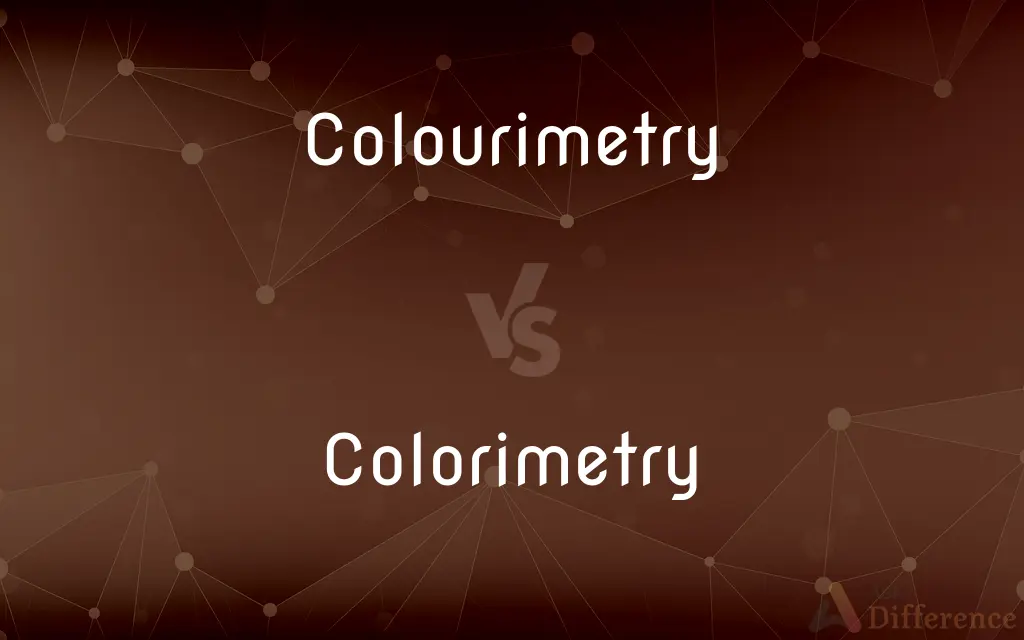Colourimetry vs. Colorimetry — What's the Difference?
Edited by Tayyaba Rehman — By Fiza Rafique — Updated on April 26, 2024
Colourimetry, used primarily in British English, and colorimetry, its American counterpart, both refer to the measurement and quantification of color in various substances.

Difference Between Colourimetry and Colorimetry
Table of Contents
ADVERTISEMENT
Key Differences
Colourimetry is the spelling preferred in British English, signifying the scientific technique of measuring color intensity and composition. On the other hand, colorimetry follows American English conventions, reflecting the same scientific practice but differing in spelling.
In the field of colourimetry, practitioners often use devices like colorimeters to analyze the colors of solutions by determining their absorbance of light at various wavelengths. Whereas in colorimetry, the same instruments and methodologies apply, but the term aligns with American spelling norms.
The application of colourimetry spans various industries, including printing and textiles in the UK, where precise color matching is crucial. Conversely, colorimetry is utilized similarly in the United States, ensuring color consistency in manufacturing and digital imaging.
Educational materials and scientific literature on colourimetry in the UK often adhere to British spelling and measurement standards. In contrast, colorimetry in the U.S. is described with American spelling and may include different measurement units, such as using inches instead of centimeters.
While debates may arise over the spelling of colourimetry versus colorimetry, the fundamental concepts, tools, and applications remain identical, emphasizing the universality of this scientific method despite regional spelling differences.
ADVERTISEMENT
Comparison Chart
Spelling
Colourimetry
Colorimetry
Usage
Predominantly in the UK
Predominantly in the US
Measurement Units
Metric system (e.g., cm, ml)
Often imperial units (e.g., inches)
Common Fields of Application
Textiles, printing
Digital imaging, manufacturing
Educational Material
British standards
American standards
Compare with Definitions
Colourimetry
Involves computation of tristimulus values.
Advanced colourimetry techniques calculate precise color data.
Colorimetry
Based on human color perception.
Colorimetry studies often explore the human eye's response to color.
Colourimetry
Measurement of the absorbance and intensity of colors in solutions.
The chemist used colourimetry to analyze dye concentrations.
Colorimetry
Essential for maintaining color accuracy in digital printing.
Colorimetry was crucial in achieving the right print hues.
Colourimetry
Utilizes instruments like colorimeters or spectrophotometers.
Colourimetry requires precise calibration of instruments.
Colorimetry
The science of measuring color characteristics.
Colorimetry helped determine the exact shade of the product.
Colourimetry
Applies Lambert-Beer's law in analysis.
Colourimetry practices often refer to Lambert-Beer's law for solution studies.
Colorimetry
Uses devices to quantify color in various media.
His research in colorimetry involved advanced digital tools.
Colourimetry
Critical in quality control of paints and fabrics.
Colourimetry ensured the consistency of fabric colors in production.
Colorimetry
Calculates color differences and similarities.
The technician used colorimetry to compare two similar colors.
Colourimetry
(analytical chemistry) colorimetry
Colorimetry
Colorimetry is "the science and technology used to quantify and describe physically the human color perception." It is similar to spectrophotometry, but is distinguished by its interest in reducing spectra to the physical correlates of color perception, most often the CIE 1931 XYZ color space tristimulus values and related quantities.
Colorimetry
Any of various instruments used to determine or specify colors, as by comparison with spectroscopic or visual standards.
Colorimetry
An instrument that measures the concentration of a known constituent of a solution by comparison with colors of standard solutions of that constituent.
Colorimetry
The science of measuring colours and assigning them numeric values.
Colorimetry
(analytical chemistry) Analysis involving the quantitative measurement of colour.
Colorimetry
The quantitative determination of the depth of color of a substance.
Colorimetry
A method of quantitative chemical analysis based upon the comparison of the depth of color of a solution with that of a standard liquid.
Colorimetry
Quantitative chemical analysis by color using a colorimeter
Common Curiosities
Are the instruments used in colourimetry and colorimetry different?
No, the instruments like colorimeters and spectrophotometers are the same; only the spelling changes.
How are colourimetry and colorimetry applied in environmental science?
Both are used in environmental science to monitor pollutants and to analyze water quality through the measurement of color changes in indicator solutions.
What is the significance of Lambert-Beer's law in colourimetry?
Lambert-Beer's law helps in determining the concentration of colored compounds in solutions, applicable in both colourimetry and colorimetry.
How does colourimetry affect industries?
It is crucial for quality control in industries like textiles and printing to ensure consistent color matching.
What role does colorimetry play in digital imaging?
Colorimetry is fundamental in digital imaging for calibrating devices to ensure that colors displayed are consistent and true to life.
What is colourimetry/colorimetry?
Colourimetry and colorimetry both refer to the method of analyzing and measuring the color of substances.
Can colourimetry be used in food industries?
Yes, both colourimetry and colorimetry are used to ensure the color quality of food products.
Is there a difference in the educational approach to colourimetry in the UK compared to colorimetry in the US?
The educational approach may differ slightly, primarily in terminology and measurement units, with the UK using metric units and the US sometimes using imperial units.
Can colourimetry be automated in industrial applications?
Yes, automation of colourimetry is common in industries such as textiles and printing, where color consistency is crucial, utilizing automated colorimeters to streamline processes.
What advancements have been made in the field of colorimetry?
Recent advancements include the development of more sophisticated spectral colorimeters and the integration of computer vision technologies to enhance color analysis accuracy and efficiency.
Share Your Discovery

Previous Comparison
Steady vs. Moderating
Next Comparison
Agate vs. SardonyxAuthor Spotlight
Written by
Fiza RafiqueFiza Rafique is a skilled content writer at AskDifference.com, where she meticulously refines and enhances written pieces. Drawing from her vast editorial expertise, Fiza ensures clarity, accuracy, and precision in every article. Passionate about language, she continually seeks to elevate the quality of content for readers worldwide.
Edited by
Tayyaba RehmanTayyaba Rehman is a distinguished writer, currently serving as a primary contributor to askdifference.com. As a researcher in semantics and etymology, Tayyaba's passion for the complexity of languages and their distinctions has found a perfect home on the platform. Tayyaba delves into the intricacies of language, distinguishing between commonly confused words and phrases, thereby providing clarity for readers worldwide.














































